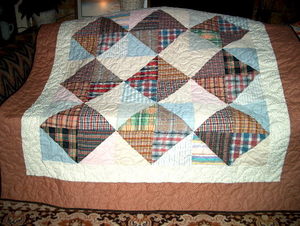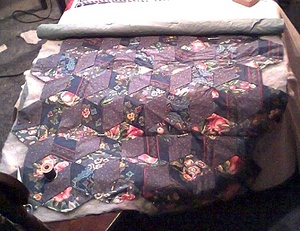Quilting has been an art form for generations. It was something that our ancestors did out of necessity and also because of a love for fabrics, color and design.
There is a great deal of very good, useful information on making a quilt. Many books have been written on the subject. I only want to give you a few basic thoughts on fabric and batting.
Quilt Batting
A quilt is composed of three layers: a top, a backing, and a batting in between to increase the warmth. Cotton batting was once the most widely used; then it was replaced by polyester. Now, the quilting world seems to have come full circle, as there are many quilters who will only use cotton.
Because cotton batting is flat and unstable, it requires a lot of quilting to prevent shifting. If you like the flat, wrinkled appearance of antique quilts, choose cotton batting and take very small quilting stitches in closely spaced lines.
Polyester batting, more stable than cotton, requires less stitching. Quilting rows may be as far apart as 3 inches.
A Word About Fabric
Weave:
Most cottons and blends have a plain weave, which makes them easier to work with than fabrics with a pile, like velvet and knit. Percale sheets are often used for quilt backs, but because they’re so firmly woven they are difficult to quilt through. Some cotton flannel, though soft, is so loosely woven that it loses its shape quickly.
Avoid twill, a diagonal weave fabric. Though it drapes well, quilters find that it stretches and is difficult to work with.
Weight:
Your fabric’s weight will influence the ease of quilting and number of stitches per inch. Very heavy fabrics are difficult or impossible to quilt; lightweight fabrics don’t hold up well and may be too soft to use.
Fiber Content:
The most widely used quilting fabrics are either all-cotton or blends of polyester and cotton. Cotton blends with 50 per cent or less polyester will look and behave more like all-cotton than blends with more polyester. To avoid differences in appearance and handling, use fabrics of the same fiber content in a project.
All-cotton fabrics wrinkle more than blends of polyester and cotton. Wrinkles are more visible in solid-color fabrics than in prints.
All-cotton fabrics have a matte finish; blends of polyester and cotton – especially those with more than 50 per cent polyester – are shinier. If you’re looking for clear, bright colors, you’ll find many in blends, though all-cotton fabrics in bright solids and prints are increasingly available.
All-cotton fabrics machine stitch more smoothly than blends, the more polyester in the blend, the more temperamental the fabric. And for turning under seam allowances in appliqué, cottons will keep a crease better than blends will. All-cotton fabrics also ravel less.
Prewashing all fabrics will help you avoid unpleasant surprises later on. Fabrics that are washed shrinks – all-cotton shrinks more than blends do. Washing removes the sizing or starch in fabric; sizing gives fabric a nice appearance but makes it more difficult to hand stitch.
Enjoy your quilting experience!



